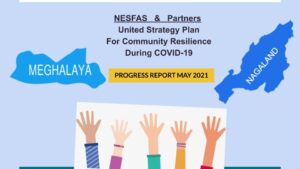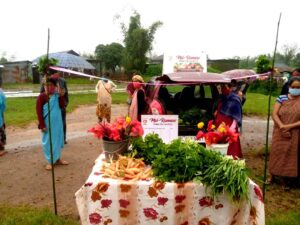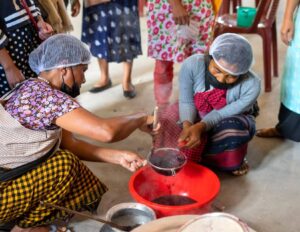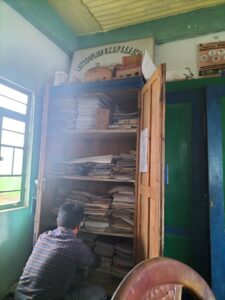
As the final days of my internship with NESFAS drew near, a fitting conclusion to my chapter, was when two of my colleagues from the Indian Institute of Public Health (IIPH) and I embarked on an adventurous three-day, two-night field trip to the serene village of Laitsohpliah nestled in the East Khasi Hills district of Meghalaya. We were tasked with conducting a baseline survey to investigate local food procurement practices and the dynamics of intercultural and sustainable exchanges within the Laitsohpliah community and schools.
Bah Nestar Kharmawphlang caught in the moment amidst conducting Intercultural SurveyWe arrived at Laitsohpliah RC UP School on July 11, 2023 and were received kindly by the headmaster, Bah Nestar Kharmawphlang. Our first assignment was to undertake an Intercultural Survey with him, which seeks to recognize and explore the value of local cultures and knowledge in educating indigenous children. By combining modern and traditional learning systems in these schools, the survey aims to provide a holistic education that respects their heritage while preparing them for the future. During this process, we learned about the school’s academic and physical amenities. It was exciting to learn that the institution was founded in 1967 and celebrated its golden jubilee in 2017. The school currently serves 58 students, with dedicated teachers educating children from nursery to class 8. We also looked through the pupils’ books, which were mostly assigned by the Meghalaya Board of School Education (MBOSE).
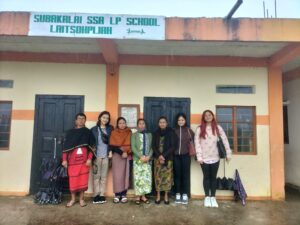
We then went to Subakalai SSA LP School, which was only a short distance away from the previous one. Unlike Laitsohpliah RC UP School, this establishment only provided lessons from Nursery to Class 5, with two teachers, a helper, and a cook. Since the teachers were more comfortable conversing in Khasi, my colleagues took charge of the intercultural survey there. The books used in this school were also prescribed by MBOSE, as they were in the preceding school. Following the completion of the survey, we went to the Mid-Day Meal Kitchen, which, despite its tiny size, impressed us with its cleanliness and efficiency. The school also provided adequate washbasin and restroom facilities, demonstrating their dedication to maintaining a sanitary atmosphere.
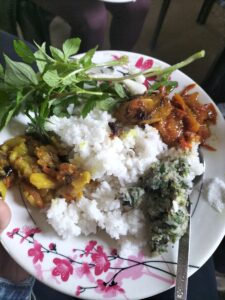
Before the day came to an end, we interviewed three ALC (Agroecology Learning Circle) farmers for the local food procurement survey, who gave us significant insight into the local community. After a full and warm dinner that left us feeling pleased and appreciative, we retired for the night at Kong’s cosy house.
The next day started early with trips to the houses of two ALC farmers for additional questioning. The exchanges went well, and we eagerly anticipated the Focused Group Discussion that evening. We convened at Laitsohpliah Community Hall at 7:30 p.m., where more than ten farmers eagerly participated in the discussion. Their cooperation was commendable, and several of them gladly waited with us until we completed filling out our questionnaires at 11 p.m. Despite the long hours, we completed our work for the day, boosted by the heartwarming dinner made by Kong, our gracious host.
We bid farewell to Kong and the kind residents of the Laitsohpliah community on the morning of our third day, who treated us with care and compassion throughout our visit. Our hearts were filled with gratitude for the experiences and insights we got throughout our stay.
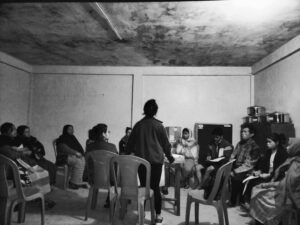
Finally, our three-day field trip to Laitsohpliah was an unforgettable adventure of discovery and intercultural interchange. The survey and discussions with the local school, farmers, and community members provided us with useful data and views that allowed us to better understand the dynamics of nutrition procurement and intercultural relationships in this village. We left our internship with fond memories and lessons that will certainly contribute to our future endeavours in community development and sustainability.
During my encounters with the school teachers, I gained a thorough grasp of the issues confronting the region’s educational system. It was disheartening to realize that these nearly 50-year-old schools could only provide education up to class 8. Another serious worry was that of teacher shortage, with only 5-6 instructors responsible for teaching all topics to students of all grades. Consequently, an insufficient number of teachers appeared to be directly related to the enrolment ratio of students in these SSA schools, highlighting the state’s struggle to provide adequate educational opportunities for children in places like Laitsohpliah, which is only an hour away from Shillong, the capital city.
As I read through the Intercultural Questionnaire for Teachers, it became clear that NESFAS was attempting to promote the relevance of cultural learning and the preservation of indigenous identity and legacy while emphasizing the importance of local biodiversity. I really hope that NESFAS will continue to support and improve the quality of basic and higher education possibilities in the places it serves while emphasizing cultural and value-added courses.
On the plus side, I was impressed with the attention of NESFAS to health and hygiene in both institutions. Students and staff were organized into groups named after fruits and took turns cleaning and organizing the school grounds, demonstrating their dedication to preserving a healthy learning environment. Furthermore, the schools’ commitment to health and hygiene was demonstrated by the installation of handwashing sinks and sufficient lavatory facilities. Notably, both schools self-sufficiently kept school gardens where basic vegetables and condiments were produced for use in midday meals. It was fascinating to me that the helpers and cooks used tobacco and water as a natural fertilizer to manage bugs and insects in the school garden.
In my discussions with the farmers, I learnt about the difficulties they encountered throughout the winter season owing to acute water scarcity, which made cultivating their crops for consumption difficult. While government intervention programmes such as the Mahatma Gandhi National Rural Job Guarantee Act (MGNREGA) and the Pradhan Mantri Gramme Sadak Yojana (PMGSY) provided some relief in the form of job and livelihood prospects, they were insufficient for long-term sustainability. Some community members tried to make ends meet by operating shops that sold daily meals and necessities.
Cold weather: warm hearts!
Despite the difficulties we encountered, the residents of Laitsohpliah were gracious hosts throughout our visit. Bah Nestar’s friendly demeanour and spontaneous support during our Intercultural Survey created an indelible impact. Kong, our host, was thoughtful and compassionate, ensuring we had nutritious meals and comfy sleeping conditions. Even in the middle of severe rain and chilling temperatures during our interviews with ALC farmers, they offered us warm red tea and lighted the traditional charcoal stove or shawla to keep us warm.
Every conversation revealed true regard and gratitude for NESFAS and its affiliates among the people of Laitsohpliah. I felt a strong sense of belonging and love for the place and its people, who welcomed me into their community. After living in the turmoil, terrible heat, and pollution of Delhi for almost a year, my visit to Laitsohpliah was the simple, refreshing, and revitalizing experience I had been yearning for. These treasured memories will live on in my heart and in images, reminding me of the magnificent times I enjoyed with the warm and welcoming people of Laitsohpliah, which I intend to revisit again in future!

